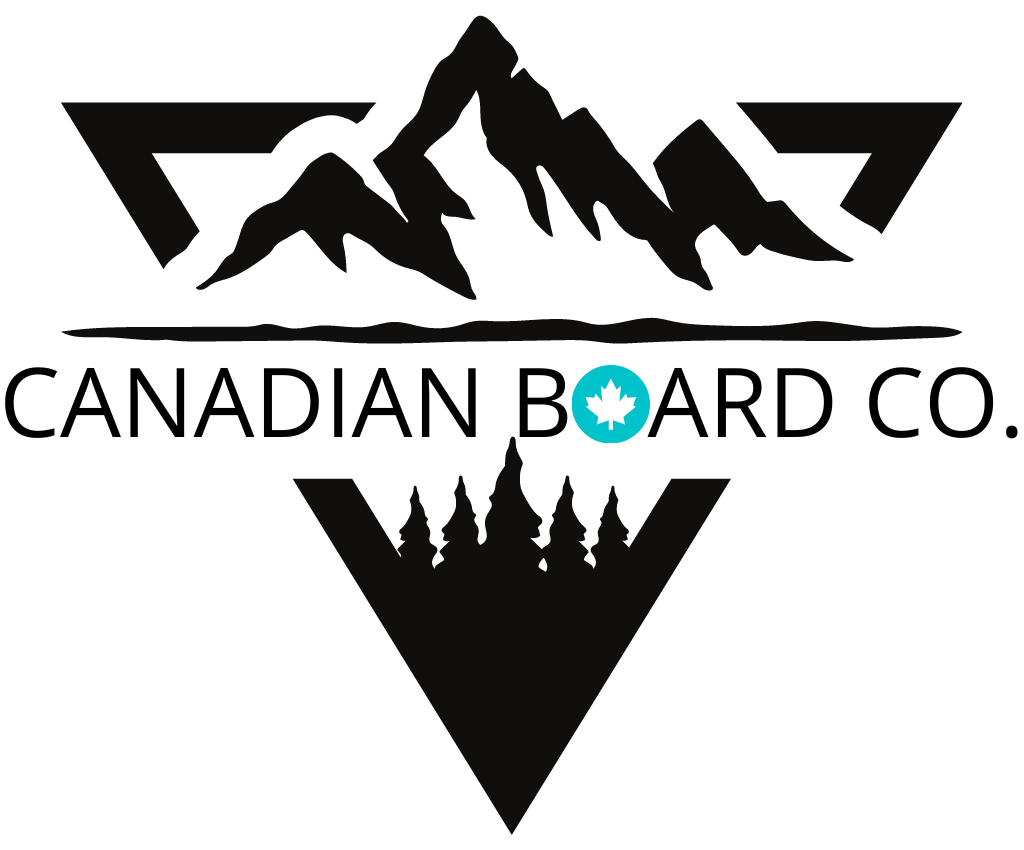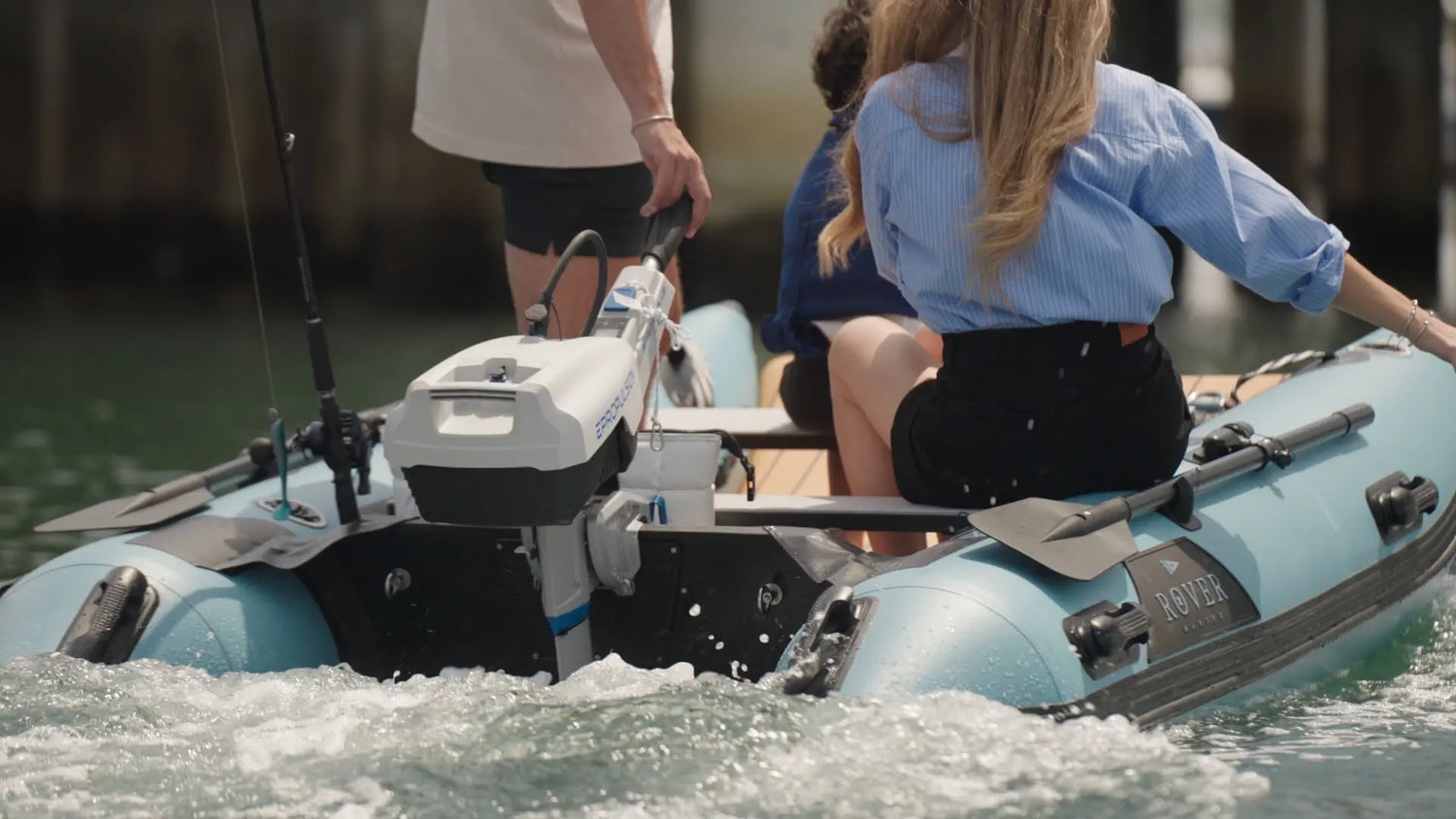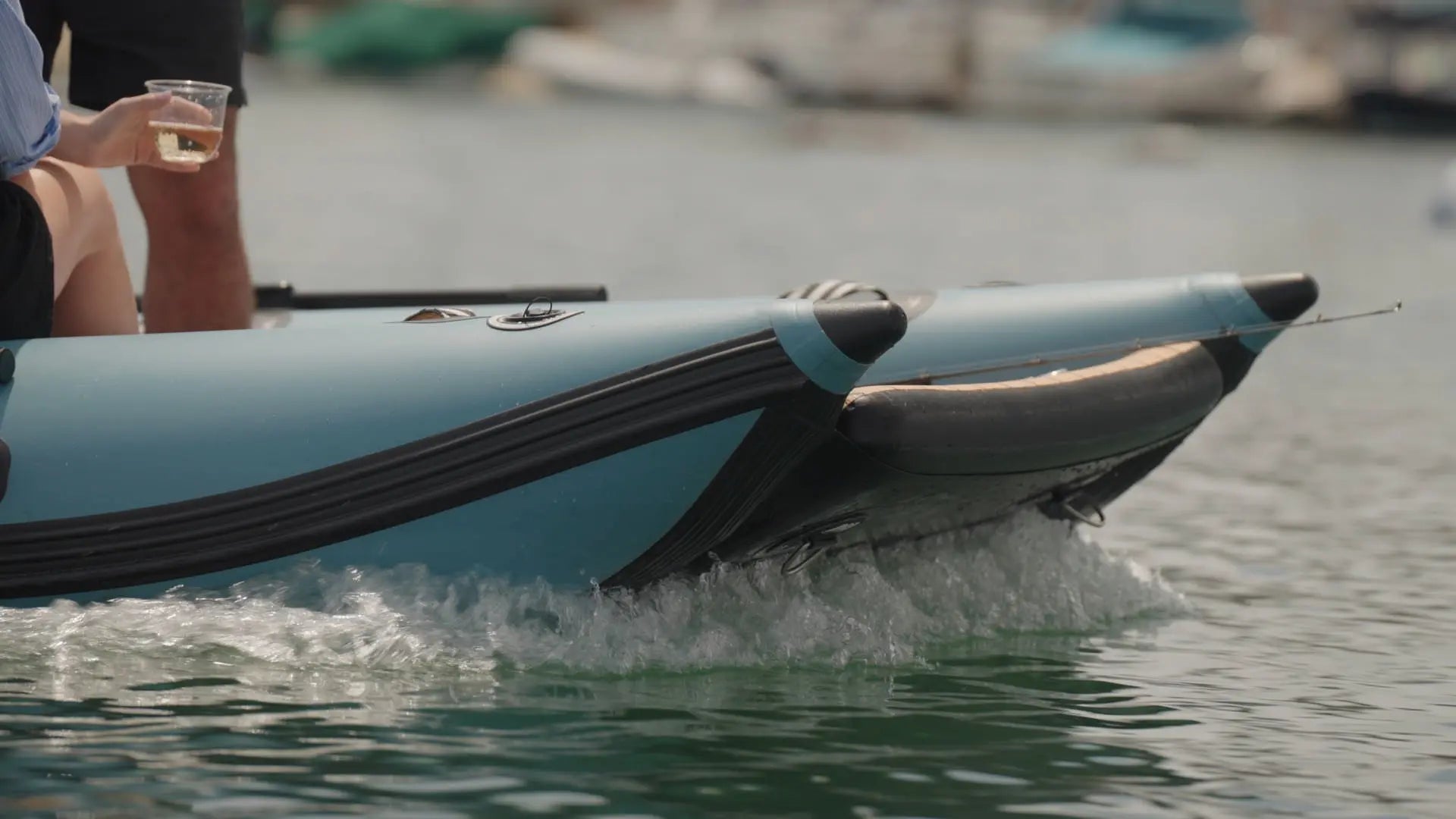Picking Your Perfect Inflatable Boat Size: The Ultimate Guide to Length, Capacity, and What You Need
The size of your inflatable boat is a game-changer for safety, how it performs, how comfy it is, and how easy it is to store on Canada's amazing lakes, rivers, and coastlines. By matching the length, width, and tube diameter to what you plan to do – whether you're a solo angler or taking the whole family out – you'll get better stability, more speed, and plenty of room on board. This guide dives deep into why boat size is so crucial, how to measure the key bits, figure out capacity, pick the right materials, hook up the perfect motor, and stay on the right side of Canadian regulations. Plus, we'll point you to some top picks from Canadian Board Co. and the Rover Marine lineup to get your next adventure rolling.
Why Does Inflatable Boat Size Even Matter? Key Things to Think About
Choosing the right inflatable boat size is all about striking a balance between four biggies: staying safe and stable, getting good performance and handling, having enough comfort and space, and making sure it's easy to move and store. Each of these points really comes down to the volume of the tubes and the floor space, so getting a handle on how they work together means you'll end up with a reliable craft that's just right for your water adventures.
How Does Boat Size Impact Safety and Stability?
A longer and wider hull means a lower centre of gravity and more buoyancy, which directly boosts your safety by making the boat less likely to tip over in rougher water. Bigger boats spread the weight more evenly across multiple air chambers, giving you a backup if one chamber happens to lose air. These safety and stability factors naturally lead into how size affects performance and handling.
What's the Deal with Size and Performance/Handling?
The length of your boat plays a big role in its top speed, while the width (beam) affects how tight a turn it can make. Longer hulls track straighter and can support higher rated horsepower, making them awesome for wide-open lakes. On the flip side, shorter hulls feel nimbler, making them champs at quick turns in rivers or navigating around obstacles, offering nimble handling when space is tight. Better control and speed mean you can match your boating style to lake, river, or coastal conditions without compromising your safety.
How Does Boat Size Affect Comfort and Space for People and Gear?
Comfort really comes down to the diameter of the tubes and the deck area: wider tubes lift your seating position and create drier zones, while longer decks can fit more seats and storage nets. The table below gives you a good idea of what to expect for adult comfort and gear storage across three common Rover Marine size categories.
| Length Class | Usable Deck Area | Typical Passenger Count |
|---|---|---|
| 8 ft (≈2.4 m) | 0.7–1 m² | 2 adults |
| 10 ft (≈3.0 m) | 1–1.4 m² | 4 adults |
| 12 ft (≈3.7 m) | 1.5–2.2 m² | 4 adults |
Smaller decks mean weight is more concentrated and there's less legroom, whereas larger platforms give you space for fishing gear, coolers, and dry bags. Finding that sweet spot between space and handling needs will guide you toward the ideal length category.
Why Are Portability and Storage So Important When Picking Boat Size?
Even the toughest inflatable boat needs to be deflated, rolled up, and stowed away efficiently if you're short on garage space or plan to trailer it often. For example, an 8 ft (≈2.4 m) Rover Marine Battle Boat folds into a compact bag (approx. 3.5 ft x 2 ft x 1 ft, weighing around 70 lbs / 32 kg) that's easy to manage. A 10 ft (≈3.0 m) model requires a larger bag (approx. 4 ft x 2.5 ft x 1.5 ft, weighing around 100 lbs / 45 kg), often best managed by two people or with a small dolly. The 12 ft (≈3.7 m) Battle Boat packs into a substantial bag (approx. 4.5 ft x 3 ft x 2 ft, weighing around 130 lbs / 59 kg), definitely a two-person job or requiring a dolly for transport. These packing features make getting from one outing to the next a total breeze.
How to Decode Inflatable Boat Size Metrics: Length, Width, and Tube Diameter
Understanding these size metrics will help you make precise comparisons and smart purchases. Length tells you the overall footprint of the hull, beam (width) dictates stability and interior room, and tube diameter controls how high the sides are and where the valves are placed.
What's the Ideal Inflatable Boat Length for Different Water Conditions?
For calm inland lakes, an 8 ft (≈2.4 m) Rover Marine Battle Boat offers enough buoyancy and is easy to handle. On gentle rivers with moderate currents, a 10 ft (≈3.0 m) model gives you extra room for maneuvering and gear. In coastal bays where you might encounter swell and chop, a 12 ft (≈3.7 m) Battle Boat or Battle Cat provides a smoother ride and higher speed under power, improving its ability to handle the sea.
How Do Beam (Width) and Tube Diameter Affect Stability and Interior Space?
A wider beam increases the boat's stability and buoyancy, helping to prevent it from rolling. A larger tube diameter raises your seating height and the freeboard (the distance from the waterline to the top of the gunwale), which helps keep spray out. These dimensions also impact how much room you have to walk around inside and how much gear you can store. Rover Marine boats feature robust tubes designed for 3.5 psi (0.24 bar) and a high-pressure drop-stitch floor rated for 10 psi (0.69 bar), ensuring optimal rigidity and performance.
How Does Inflatable Boat Length Influence Speed and Manoeuvrability?
Longer hulls reduce water resistance and track straighter when powered up, which can lead to higher top speeds. Shorter hulls turn more sharply and respond quicker to throttle changes, which is ideal for fishing around reefs or exploring narrow shorelines. Choosing a length that suits your main type of water will make handling smoother and improve fuel efficiency.
Marine research indicates that a boat's length is a critical factor influencing its maximum efficient speed and overall hydrodynamic performance. Longer hulls generally experience reduced water resistance at higher speeds, as the waves they generate at speed are longer and move faster. This principle highlights how increased length can lead to greater efficiency and speed in various water conditions.
The Relationship Between Boat Length, Speed, and Hydrodynamic Performance
This research directly supports the article's explanation of how boat length influences speed, tracking potential, and resistance, particularly in the context of open lakes and coastal conditions.
How to Calculate Inflatable Boat Capacity: Passengers and Weight Limits
Knowing the maximum payload is key to preventing overloading, maintaining performance, and sticking to safety rules. Capacity ratings combine the number of passengers and the maximum weight into a single figure.
What's the Maximum Passenger Capacity for Different Boat Sizes?
| Boat Length | Rated Passenger Count | Load Limit (lb / kg) |
|---|---|---|
| 8 ft (≈2.4 m) | 2 adults | 600 lb (≈272 kg) |
| 10 ft (≈3.0 m) | 4 adults | 1000 lb (≈454 kg) |
| 12 ft (≈3.7 m) | 4 adults | 1200 lb (≈544 kg) |
How to Factor in Gear, Motor, and Fuel for Weight Capacity?
Always subtract the combined weight of your heavy gear – like the battery, outboard motor, and fuel – before you start loading passengers. For example, a 10 hp outboard (35 kg), a full fuel tank (20 kg), and your fishing kit (15 kg) add up to about 70 kg (≈154 lb), which reduces your available payload by that much.
What Are Safe Loading Practices to Avoid Overloading?
- Always check the manufacturer’s maximum load plate before you get in.
- Distribute weight evenly from front to back, keeping heavy items close to the centre.
- Don't add more gear once you're getting close to the capacity limit.
Following these practices helps maintain the manufacturer-rated stability and extends the life of your boat.
How to Match Inflatable Boat Size to Your Intended Use in Canada
What you plan to do – fishing, family fun, acting as a yacht tender, or exploring – will determine the ideal dimensions. Understanding these different scenarios will help you pick the right length and beam.
What Are the Best Inflatable Boat Sizes for Fishing Adventures?
Solo anglers will do great with an 8 ft (≈2.4 m) Rover Marine Battle Boat that fits in most vehicles and can handle electric trollers. For two anglers, a 10 ft (≈3.0 m) Battle Boat offers enough space for tackle boxes, rod holders, and fish finders. The Rover Marine Battle Boat, available in 8 ft, 10 ft, and 12 ft sizes, is a super stable platform for both lakes and riverbanks.
Which Inflatable Boat Sizes Work Best for Family Leisure and Recreation?
Families of three to four will appreciate 10 ft (≈3.0 m) or 12 ft (≈3.7 m) Battle Boat models with air-deck floors that make them more comfortable. These larger platforms provide ample space for coolers and dry bags, ensuring a comfortable outing for everyone.
What Size Inflatable Boat Is Ideal as a Yacht Tender or Dinghy?
Compact tenders in the 8 ft (≈2.4 m) range, like the Rover Marine Battle Boat, can be stowed under davits and inflate quickly for ferrying guests or supplies. For larger yachts, a 10 ft (≈3.0 m) Battle Boat offers a versatile platform for short trips.
How to Choose Larger Boats for Adventure and Challenging Water Conditions?
When you're exploring remote coastlines or dealing with fast currents, a 12 ft (≈3.7 m) Battle Boat or the Rover Marine Battle Cat Inflatable Catamaran are excellent choices. These sizes can handle wind chop and support higher horsepower. The Battle Cat is a prime example of how its unique catamaran hull design provides exceptional load capacity and comfort for multi-day trips.
What Are the Different Inflatable Boat Types and Their Size Implications?
The type of boat you choose affects hull rigidity, deck systems, and material thickness, all of which interact with size to influence how it performs.
Mono-hull (Battle Boat) vs. Catamaran (Battle Cat): What's the Difference?
The Rover Marine Battle Boat features a traditional mono-hull design, offering a classic inflatable boat experience with excellent stability and maneuverability for general use. In contrast, the Rover Marine Battle Cat utilizes a twin-hull catamaran design. This provides a wider, more stable platform, often with a shallower draft, making it ideal for heavy loads, shallow waters, and a smoother ride in chop. The catamaran design also offers a larger usable deck area for its length, enhancing comfort and space for gear.
What Are the Size Benefits of Roll-Up and Air Deck Inflatable Boats?
All Rover Marine boats are roll-up models that can be packed down into compact bags, making even the 8 ft (≈2.4 m) sizes super portable for car-top transport. Our air-deck designs add rigidity, allowing larger lengths like the 10 ft (≈3.0 m) and 12 ft (≈3.7 m) models to feel solid underfoot while still being packable for storage.
How Do Materials Affect Inflatable Boat Size and Durability?
The choice of material impacts the thickness of the tube walls, UV resistance, and overall lifespan, all of which are critical when selecting the right size.
What Are the Differences Between PVC, Hypalon, and TPU for Boat Size Durability?
Triple-layer reinforced PVC is a lightweight, affordable, and strong option, offering multiple coatings over a heavy-duty base fabric to improve UV, puncture, and abrasion resistance. Hypalon provides superior UV and chemical resistance but is generally heavier and costlier. TPU offers high flexibility and tear resistance, though its use in large inflatable boats is less common. Opting for high-quality PVC, like the triple-layer reinforced PVC used in Rover Marine boats, ensures the boat maintains its shape and integrity over time.
How Does Boat Size Impact Storage and Transport Based on Material?
An 8 ft (≈2.4 m) PVC craft can be compressed into a single backpack-style bag. A 10 ft (≈3.0 m) PVC boat will need a robust carry bag, often best managed by two people. A 12 ft (≈3.7 m) PVC vessel requires a substantial carry bag, often with wheels or a dolly for easier transport. Matching the material to the size makes transport manageable and reduces wear and tear during frequent use.
How to Choose the Right Motor Size for Your Inflatable Boat Length
Pairing the motor's power with your hull's length prevents under- or over-powering, which can mess with performance or safety.
What Outboard Motor Horsepower Matches Different Inflatable Boat Sizes?
- 8 ft (≈2.4 m) Rover Marine Battle Boat: Up to 6 HP for excellent maneuverability and efficiency.
- 10 ft (≈3.0 m) Rover Marine Battle Boat: Up to 10 HP for comfortable cruising and good load handling.
- 12 ft (≈3.7 m) Rover Marine Battle Boat or Battle Cat: Up to 20 HP for handling full loads, higher speeds, and superior sea-keeping.
Are Electric Outboards Suitable for Various Inflatable Boat Lengths?
Absolutely! Electric outboards like the Torqeedo Travel 1103 S work great with 8 ft to 10 ft (≈2.4–3.0 m) Rover Marine inflatables. They provide quiet, emission-free power for fishing and leisure without the racket of gas motors. Runtime will depend on battery capacity and the load you're carrying.
What Are the Canadian Safety Regulations and Best Practices for Inflatable Boat Sizes?
Transport Canada's guidelines set out the mandatory equipment and loading practices based on size and passenger count.
What Safety Gear Is Essential for Different Inflatable Boat Sizes in Canada?
Every inflatable boat operating in Canada needs to have:
- Approved life jackets or PFDs for every person on board
- Bailers or manual bilge pumps
- A sound-signalling device (like a whistle or horn)
- Navigation lights if you plan to be out after dark
Transport Canada's Small Vessel Regulationsand Construction Standards for Small Vessels (TP 1332E) establish mandatory safety equipment, capacity limits, and construction requirements for inflatable boats in Canada. These guidelines ensure safe operation by detailing requirements for essential gear like life jackets, bailers, and sound-signalling devices, and by mandating visible load plates that specify maximum gross load based on buoyancy and vessel weight. Always consult the official Transport Canada resources for the most current and comprehensive information.
Canadian Regulations for Small Vessels and Inflatable Boat Safety
This research directly supports the article's sections on Canadian regulations, essential safety gear, and capacity rules for inflatable boats.
How Do Canadian Boating Regulations Affect Inflatable Boat Capacity and Use?
Regulations limit passenger numbers to the manufacturer's ratings and require visible load plates. Going over capacity can result in fines and void your insurance. Always check local bylaws for speed limits on lakes and rivers.
How to Find Your Perfect Inflatable Boat Size with Canadian Board Co. and Rover Marine
Canadian Board Co. offers expert advice and a carefully selected range of Rover Marine inflatables to suit every Canadian adventure.
What Are the Size Options in the Rover Marine Battle Boat Series?
The Battle Boat is available in 8 ft (≈2.4 m), 10 ft (≈3.0 m), and 12 ft (≈3.7 m) models. These boats feature aluminum bench seats, a high-pressure drop-stitch floor (10 psi / 0.69 bar), and robust tubes (3.5 psi / 0.24 bar). Maximum capacities are 600 lbs (≈272 kg) for the 8 ft, 1000 lbs (≈454 kg) for the 10 ft, and 1200 lbs (≈544 kg) for the 12 ft. These lengths strike a great balance between being portable and offering plenty of deck space for passengers and their gear.

How Does Canadian Board Co. Help You Choose the Right Inflatable Boat Size?
Our awesome customer service team is here to provide one-on-one consultations to help you find the right size, offer an industry-leading 3-Year Warranty and a 60-Day Rider’s Guarantee, and provide free Canada-wide shipping on most orders. We pack every order with care and back our boats with an industry-leading warranty – so you can explore with total confidence.
Families and anglers alike trust Canadian Board Co. to help them navigate the sizing puzzle and deliver the perfect inflatable craft for every water-based adventure. Check out our social channels on Facebook, Instagram, and YouTube for setup demos, real-world reviews, and fresh ideas to make the most of your time on the water.







Leave a comment
All comments are moderated before being published.
This site is protected by hCaptcha and the hCaptcha Privacy Policy and Terms of Service apply.